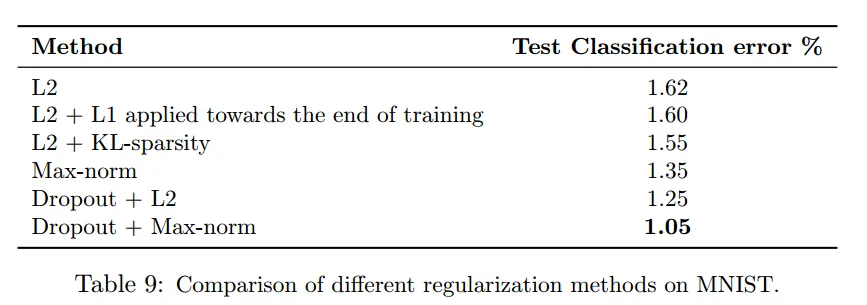我目前正在参加优达学城深度学习课程,其中涉及到人工神经网络(ANN)。
我已经成功地构建和训练了网络,并对所有权重和偏差引入了L2正则化。现在,我正在尝试使用隐藏层的dropout来提高泛化性能。我想知道,在隐藏层引入L2正则化并使用dropout是否有意义?如果有,如何正确操作?
在dropout期间,我们会关闭隐藏层中一半的激活,将其余神经元输出的数量翻倍。当使用L2时,我们会计算所有隐藏权重的L2范数。但我不确定在使用dropout时如何计算L2范数。我们关闭了一些激活,难道我们不应该从L2计算中删除现在“未使用”的权重吗?关于这个问题的任何参考资料都会有用,我没有找到任何信息。
如果您感兴趣,以下是我使用L2正则化的ANN代码:
#for NeuralNetwork model code is below
#We will use SGD for training to save our time. Code is from Assignment 2
#beta is the new parameter - controls level of regularization. Default is 0.01
#but feel free to play with it
#notice, we introduce L2 for both biases and weights of all layers
beta = 0.01
#building tensorflow graph
graph = tf.Graph()
with graph.as_default():
# Input data. For the training data, we use a placeholder that will be fed
# at run time with a training minibatch.
tf_train_dataset = tf.placeholder(tf.float32,
shape=(batch_size, image_size * image_size))
tf_train_labels = tf.placeholder(tf.float32, shape=(batch_size, num_labels))
tf_valid_dataset = tf.constant(valid_dataset)
tf_test_dataset = tf.constant(test_dataset)
#now let's build our new hidden layer
#that's how many hidden neurons we want
num_hidden_neurons = 1024
#its weights
hidden_weights = tf.Variable(
tf.truncated_normal([image_size * image_size, num_hidden_neurons]))
hidden_biases = tf.Variable(tf.zeros([num_hidden_neurons]))
#now the layer itself. It multiplies data by weights, adds biases
#and takes ReLU over result
hidden_layer = tf.nn.relu(tf.matmul(tf_train_dataset, hidden_weights) + hidden_biases)
#time to go for output linear layer
#out weights connect hidden neurons to output labels
#biases are added to output labels
out_weights = tf.Variable(
tf.truncated_normal([num_hidden_neurons, num_labels]))
out_biases = tf.Variable(tf.zeros([num_labels]))
#compute output
out_layer = tf.matmul(hidden_layer,out_weights) + out_biases
#our real output is a softmax of prior result
#and we also compute its cross-entropy to get our loss
#Notice - we introduce our L2 here
loss = (tf.reduce_mean(tf.nn.softmax_cross_entropy_with_logits(
out_layer, tf_train_labels) +
beta*tf.nn.l2_loss(hidden_weights) +
beta*tf.nn.l2_loss(hidden_biases) +
beta*tf.nn.l2_loss(out_weights) +
beta*tf.nn.l2_loss(out_biases)))
#now we just minimize this loss to actually train the network
optimizer = tf.train.GradientDescentOptimizer(0.5).minimize(loss)
#nice, now let's calculate the predictions on each dataset for evaluating the
#performance so far
# Predictions for the training, validation, and test data.
train_prediction = tf.nn.softmax(out_layer)
valid_relu = tf.nn.relu( tf.matmul(tf_valid_dataset, hidden_weights) + hidden_biases)
valid_prediction = tf.nn.softmax( tf.matmul(valid_relu, out_weights) + out_biases)
test_relu = tf.nn.relu( tf.matmul( tf_test_dataset, hidden_weights) + hidden_biases)
test_prediction = tf.nn.softmax(tf.matmul(test_relu, out_weights) + out_biases)
#now is the actual training on the ANN we built
#we will run it for some number of steps and evaluate the progress after
#every 500 steps
#number of steps we will train our ANN
num_steps = 3001
#actual training
with tf.Session(graph=graph) as session:
tf.initialize_all_variables().run()
print("Initialized")
for step in range(num_steps):
# Pick an offset within the training data, which has been randomized.
# Note: we could use better randomization across epochs.
offset = (step * batch_size) % (train_labels.shape[0] - batch_size)
# Generate a minibatch.
batch_data = train_dataset[offset:(offset + batch_size), :]
batch_labels = train_labels[offset:(offset + batch_size), :]
# Prepare a dictionary telling the session where to feed the minibatch.
# The key of the dictionary is the placeholder node of the graph to be fed,
# and the value is the numpy array to feed to it.
feed_dict = {tf_train_dataset : batch_data, tf_train_labels : batch_labels}
_, l, predictions = session.run(
[optimizer, loss, train_prediction], feed_dict=feed_dict)
if (step % 500 == 0):
print("Minibatch loss at step %d: %f" % (step, l))
print("Minibatch accuracy: %.1f%%" % accuracy(predictions, batch_labels))
print("Validation accuracy: %.1f%%" % accuracy(
valid_prediction.eval(), valid_labels))
print("Test accuracy: %.1f%%" % accuracy(test_prediction.eval(), test_labels))
